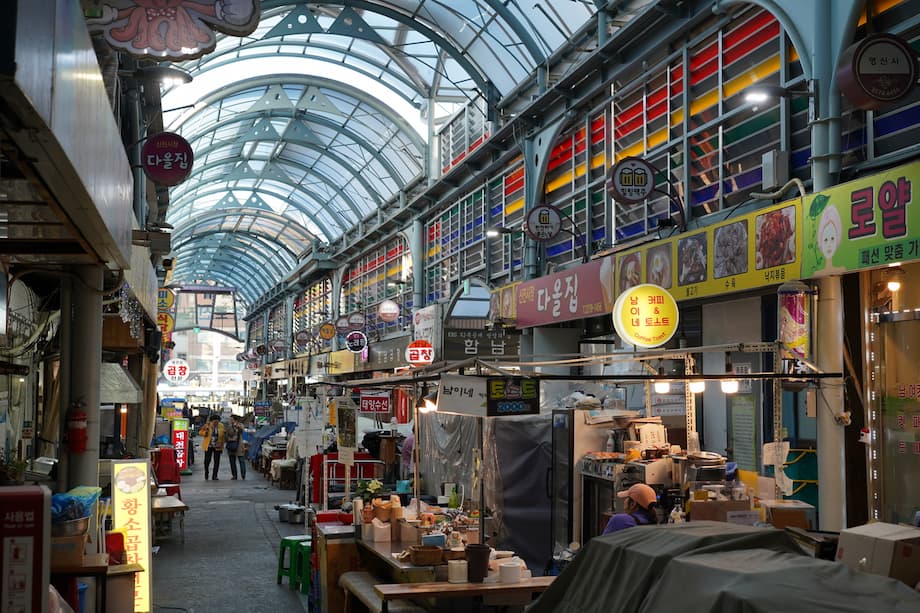Discovering Jongno Sinjin Market: A Glimpse into Seoul’s Authentic Market Culture
In the heart of Seoul’s historic Jongno-gu district, where ancient palaces and modern skyscrapers coexist, lies a lesser-known but deeply cherished traditional market: Jongno Sinjin Market. While names like Gwangjang Market and Dongdaemun Fashion Wholesale Market often dominate travel guides, Jongno Sinjin Market offers a more intimate, authentic experience for those seeking to immerse themselves in the everyday rhythms of Korean life. Established in 1952, this market stands as a living testament to Seoul’s resilience, adaptability, and culinary heritage.
- Discovering Jongno Sinjin Market: A Glimpse into Seoul’s Authentic Market Culture
- What Makes Jongno Sinjin Market Unique?
- Culinary Treasures: A Foodie’s Paradise
- Jongno Sinjin Market in the Context of Seoul’s Market Culture
- Practical Tips for Visiting Jongno Sinjin Market
- The Broader Significance: Why Traditional Markets Matter
- In Summary
Jongno-gu itself is renowned for its cultural significance, housing iconic sites such as Changdeokgung Palace and the bustling Insadong arts district. Yet, it is in its traditional markets that the district’s soul truly shines. Jongno Sinjin Market, though smaller and more understated than its famous neighbors, has quietly become a beloved destination for locals and adventurous travelers alike.
What Makes Jongno Sinjin Market Unique?
Unlike the sprawling, tourist-packed markets elsewhere in Seoul, Jongno Sinjin Market retains a distinctly local flavor. It is an indoor market, offering shelter from the city’s unpredictable weather and a cozy, bustling atmosphere. The market’s origins trace back to the post-Korean War era, when it was primarily known for selling hiking gear and military clothing. Over the decades, it evolved to meet the changing needs of the community, but traces of its past remain visible in the handful of tailor shops that still operate today.
One elderly tailor, now in his seventies, recalls a time when the market’s main street was lined with bustling tailoring stalls. “A few years ago, the main street of Jongno Sinjin Market was filled with tailor shops and customers waiting for their jackets and trousers to get tailored,” he explained.
“Now, only five or six shops remain, but we still see regulars coming in to have their sleeves taken up or pant legs lengthened.”
This enduring presence of tailors is a rare sight in modern Seoul, where fast fashion and mass production have largely replaced bespoke clothing.
Beyond tailoring, the market is a microcosm of Seoul’s evolving retail landscape. Stalls offer affordable goods ranging from household items to clothing, with prices that attract budget-conscious shoppers. The market’s unpretentious, sometimes gritty ambiance is part of its charm, drawing those who value authenticity over polish.
A Local’s Market: Who Shops Here?
Jongno Sinjin Market is frequented primarily by locals, especially those in their 50s and 60s, seeking both nostalgia and practicality. Unlike the more tourist-oriented markets, it is not typically crowded with foreign visitors, making it an ideal spot for those wishing to observe daily life in Seoul. According to visitor reviews, the market’s atmosphere is extraordinary—lively, welcoming, and distinctly Korean. It is not uncommon to encounter a mix of regulars and curious travelers, all drawn by the promise of affordable street food and genuine human connection.
Culinary Treasures: A Foodie’s Paradise
Perhaps the greatest draw of Jongno Sinjin Market is its food. The narrow alleyways extending from the market’s eastern gate are lined with eateries serving a mouthwatering array of classic Korean dishes. Here, the focus is on hearty, comforting fare—perfect for Seoul’s chilly winters or a quick, satisfying lunch.
Signature dishes include:
- Dakhanmari: A whole chicken simmered in broth with vegetables, served in a communal pot. While reminiscent of the herbal chicken soup samgyetang, dakhanmari is simpler and more rustic, emphasizing the natural flavors of the chicken and broth.
- Gopchang: Grilled or stewed small intestines of cows and pigs, beloved for their chewy texture and rich flavor.
- Sundae Gukbap: A hearty soup featuring Korean blood sausage (sundae) and rice, often enjoyed as a filling, affordable meal.
- Grilled Fish and Bulgogi: Classic staples that showcase the depth and variety of Korean home cooking.
Many of these eateries have been family-run for generations, their recipes passed down and perfected over decades. Prices remain modest, making the market a favorite among nearby office workers and residents. As evening falls, the market comes alive with the clatter of chopsticks and the convivial clinking of soju glasses, as locals unwind over steaming bowls of soup and shared plates.
One visitor described the experience:
“I ate here nearby and met Englishmen, Germans, Cubans. Cheap street food, cooked right in front of you. The atmosphere is extraordinary—this is where you feel the real Seoul.”
Changing Food Traditions: From Dog Meat to Chicken Soup
The culinary landscape of Seoul’s traditional markets is not static. Recent years have seen significant shifts, particularly with the decline of dog meat restaurants following new legislation and changing social attitudes. In Jongno Sinjin Market, as in other parts of the city, vendors have adapted by focusing on alternative energy-boosting dishes such as baeksuk (chicken soup), eel, and black goat stew. These dishes, once considered seasonal or specialty fare, are now enjoying a surge in popularity, especially during Korea’s sweltering summer months.
This transition reflects broader trends in Korean society, where rising pet ownership and animal welfare concerns have prompted a reevaluation of culinary traditions. The government’s recent ban on the dog meat trade, set to take full effect in 2027, has accelerated this change. As a result, markets like Jongno Sinjin are at the forefront of a new era in Korean food culture—one that honors tradition while embracing evolving tastes and values.
Jongno Sinjin Market in the Context of Seoul’s Market Culture
To fully appreciate Jongno Sinjin Market, it helps to understand its place within Seoul’s broader market ecosystem. The city is home to dozens of traditional markets, each with its own character and specialties. Gwangjang Market, for example, is famous for its vast food alleys and historic tailoring boutiques, while Dongdaemun Market is a mecca for fashion enthusiasts. Other notable markets include Namdaemun (offering everything from clothing to souvenirs), Dongmyo Flea Market (antiques and vintage goods), and Mangwon Market (affordable street food).
What sets Jongno Sinjin apart is its scale and focus. While larger markets cater to mass tourism and wholesale trade, Sinjin remains rooted in the local community. Its smaller size fosters a sense of intimacy and familiarity, allowing visitors to interact directly with vendors and artisans. The market’s indoor layout provides a comfortable shopping environment year-round, and its location—just a short walk from Dongdaemun Gate—makes it easily accessible yet pleasantly removed from the city’s busiest thoroughfares.
According to travel guides and user reviews, Jongno Sinjin Market is an excellent place to:
- Sample authentic Korean street food at reasonable prices
- Shop for affordable clothing, household goods, and tailored garments
- Experience the rhythms of local life, away from tourist crowds
- Meet people from diverse backgrounds, both local and international
Comparisons with Other Markets
While markets like Gwangjang and Namdaemun attract throngs of visitors with their sheer size and variety, they can sometimes feel overwhelming. Jongno Sinjin, by contrast, offers a slower pace and a more personal touch. It is particularly well-suited for travelers who value authenticity over spectacle, and who wish to delve deeper into Seoul’s everyday culture.
Other markets in Jongno-gu, such as Ssamzigil and Jongno 3 Stalls Alley, also offer unique experiences—Ssamzigil with its artsy, circular shopping center and Jongno 3 Stalls Alley with its lively food stalls and pubs. Yet, Sinjin Market’s blend of tradition, affordability, and community spirit sets it apart as a hidden gem.
Practical Tips for Visiting Jongno Sinjin Market
For those planning a visit, a few practical tips can enhance the experience:
- Getting There: The market is located at the end of Jongno, about a 10 to 15 minute walk from Dongdaemun Gate. It is easily accessible by subway or bus.
- Best Time to Visit: The market is lively throughout the day, but evenings are especially vibrant as local workers gather for dinner and drinks. Weekdays tend to be less crowded than weekends.
- What to Bring: Carry some cash, as not all vendors accept credit cards. Comfortable shoes are recommended for navigating the narrow alleys.
- Food Safety: While the market is not known for high-end hygiene, the food is generally safe and delicious. Choose busy stalls for fresher fare.
- Language: English is not widely spoken, but vendors are friendly and transactions are straightforward. A smile and a few basic Korean phrases go a long way.
What Not to Miss
Be sure to try the market’s signature dishes, especially dakhanmari and sundae gukbap. If you’re feeling adventurous, sample the gopchang or grilled fish. For those interested in Korean tailoring, consider having a garment altered by one of the remaining master tailors—a unique souvenir and a nod to the market’s storied past.
The Broader Significance: Why Traditional Markets Matter
Traditional markets like Jongno Sinjin are more than just places to shop or eat—they are vital threads in the fabric of Korean society. They provide livelihoods for small business owners, preserve culinary and craft traditions, and foster a sense of community in an increasingly fast-paced, digital world. As Seoul continues to modernize, these markets serve as living museums, offering glimpses into the city’s history and identity.
Moreover, the survival and adaptation of markets like Sinjin reflect broader societal changes. The shift away from dog meat, the resilience of family-run eateries, and the enduring appeal of tailored clothing all speak to Korea’s ability to honor its past while embracing the future. For visitors, these markets offer not just goods and meals, but stories—of hardship and hope, of change and continuity.
In Summary
- Jongno Sinjin Market is a hidden gem in Seoul’s historic Jongno-gu district, offering an authentic traditional market experience.
- Established in 1952, the market is known for its tailoring heritage, affordable goods, and vibrant street food scene.
- The market is frequented mainly by locals, providing a genuine glimpse into everyday Korean life.
- Signature dishes include dakhanmari, gopchang, sundae gukbap, and grilled fish, served in cozy, family-run eateries.
- Recent shifts in Korean food culture, including the decline of dog meat and the rise of alternative dishes, are reflected in the market’s offerings.
- Jongno Sinjin Market stands out for its intimacy, community spirit, and commitment to tradition amid Seoul’s rapid modernization.
- Visiting the market is a must for travelers seeking to experience the real Seoul—its flavors, its people, and its enduring spirit.












